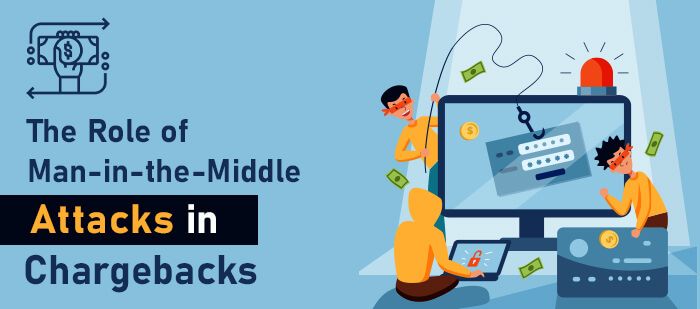
In the complex and dynamic landscape of digital transactions, the threat of Man-in-the-Middle (MitM) attacks looms large, presenting significant challenges for businesses and financial institutions alike. These cyber-attacks, where an unauthorized entity intercepts or alters the communication between two parties without their knowledge, have far-reaching implications, particularly in the context of chargebacks.
This blog post delves into the role of Man-in-the-Middle attacks in chargebacks, offering insights into understanding these attacks, their impact, challenges in detection and prevention, effective strategies for mitigation, and the future of combating such threats in the chargeback industry.
Understanding Man-in-the-Middle Attacks
A Man-in-the-Middle (MitM) attack is a cybersecurity breach that involves an unauthorized individual secretly relaying and possibly altering the communication between two parties who believe they are directly communicating with each other. This type of cyber threat is particularly insidious because it can occur without the detection of either party involved in the communication.
The attacker can intercept sensitive data, such as login credentials, credit card information, or other personal data, to later use for fraudulent purposes or sell on the dark web. These attacks exploit vulnerabilities in the communication process, using various methods such as compromised security certificates, phishing emails, or unsecured public WiFi networks.
The attackers’ goal is often to gather enough information to commit identity theft, financial fraud, or even corporate espionage. Given their covert nature, MitM attacks present a unique challenge in both detection and prevention, necessitating heightened vigilance and robust security measures to protect against unauthorized data interception and manipulation.
Some Related Blogs
- Credential Stuffing: A Growing Concern for Chargeback Professionals
- Understanding the Process: Your Bank Account Under Investigation
- The Impact of Chargeback Time Limit on Your Business
- Get to Know Your Visa Chargeback Time Limits
The Impact of MitM Attacks on Chargebacks
MitM attacks significantly exacerbate the challenges within the chargeback process, a mechanism intended to safeguard consumers against fraudulent transactions. These cyber-attacks can result in unauthorized purchases, with attackers utilizing intercepted information to carry out transactions that ultimately lead to chargeback claims once detected by the legitimate cardholder.
This creates a problematic scenario for merchants and financial institutions, as the altered or intercepted communication and transaction records during MitM attacks complicate the dispute resolution process. Merchants face difficulties in providing convincing evidence of legitimate transactions, leading to increased financial losses through both the cost of lost goods and the imposition of additional chargeback fees.
Moreover, such incidents erode customer trust and jeopardize long-standing relationships, as customers may feel vulnerable and inadequately protected against future fraud. This intricate web of challenges underscores the critical need for robust security measures and vigilance to minimize the occurrence and impact of MitM attacks on chargebacks.
Challenges in Detecting and Preventing MitM Attacks
Detecting and thwarting MitM attacks remains a formidable challenge for both businesses and financial institutions due to the stealthy and evolving nature of these cyber threats. Attackers deploy a myriad of techniques to intercept or alter communications, including exploiting security vulnerabilities in public Wi-Fi networks and crafting sophisticated phishing schemes.
![]()
Email us anytime!
Email customer service 24/7
![]()
Call us anytime!
Reach customer care 24/7 at +1 (888) 901-8653
This complexity necessitates a nuanced and adaptive approach to cybersecurity. Traditional defenses, while foundational, may fall short against the creativity and persistence of modern cybercriminals, who continuously refine their methods to circumvent established security protocols. Furthermore, the dependency on secure and encrypted communication channels introduces additional vulnerabilities, as attackers seek to exploit any weak links in the digital chain of trust.
The dynamic battlefield of cyber security demands constant vigilance and the implementation of advanced protective measures to detect the subtle indicators of MitM activity. Without a robust and flexible security framework, organizations remain at risk of these invasive attacks, highlighting the critical need for ongoing investment in cybersecurity innovation and education to safeguard sensitive communications against the sophisticated tactics employed by adversaries.
Strategies for Mitigating the Risk of MitM Attacks
To effectively combat the threat of Man-in-the-Middle attacks, organizations should deploy a multifaceted defense strategy that bolsters their cybersecurity posture. Key tactics include the use of stringent encryption methods for safeguarding data transmitted online, and ensuring that all communication channels are secured with protocols like HTTPS.
Additionally, raising awareness about MitM threats among customers and staff is crucial; this involves training on identifying suspicious emails and the dangers of connecting to unsecured Wi-Fi networks.
Implementing sophisticated security measures, such as multi-factor authentication (MFA), can significantly enhance protection by adding an extra layer of verification for users accessing sensitive information. Organizations should also be proactive in monitoring transaction and communication logs for anomalies that may indicate a breach or interception attempt.
Collaborating with cybersecurity experts or integrating advanced technology solutions, including AI and machine learning, can provide dynamic and effective defense mechanisms capable of identifying and neutralizing threats in their infancy.
By adopting these proactive and comprehensive strategies, businesses can fortify their defenses against the sophisticated tactics used by attackers in MitM scenarios, thereby reducing the likelihood of successful attacks and minimizing their potential impact on chargebacks.
The Future of MitM Attack Prevention in the Chargeback Industry
As we navigate the evolving digital terrain, the methodologies for thwarting Man-in-the-Middle attacks and lessening their effects on chargebacks are set to transform. The advancement in cybersecurity technology coupled with the implementation of innovative security protocols marks a promising path forward.
Notably, the integration of blockchain technology is poised to revolutionize transaction security by offering a decentralized and immutable record-keeping mechanism, which inherently resists MitM interference.
Concurrently, the potential of quantum encryption to provide exceedingly strong security measures could redefine the standards of secure communication. Moreover, the utilization of AI and machine learning for the swift identification and neutralization of cyber threats is expected to become increasingly prevalent, offering more agile and effective defense strategies.
The chargeback industry must evolve in tandem, refining dispute resolution practices to navigate the challenges posed by these sophisticated attacks. This entails not only improving the verification processes for chargeback disputes but also setting more rigorous criteria for the documentation of transactions, ensuring a resilient stance against the ever-changing tactics of cyber adversaries.





